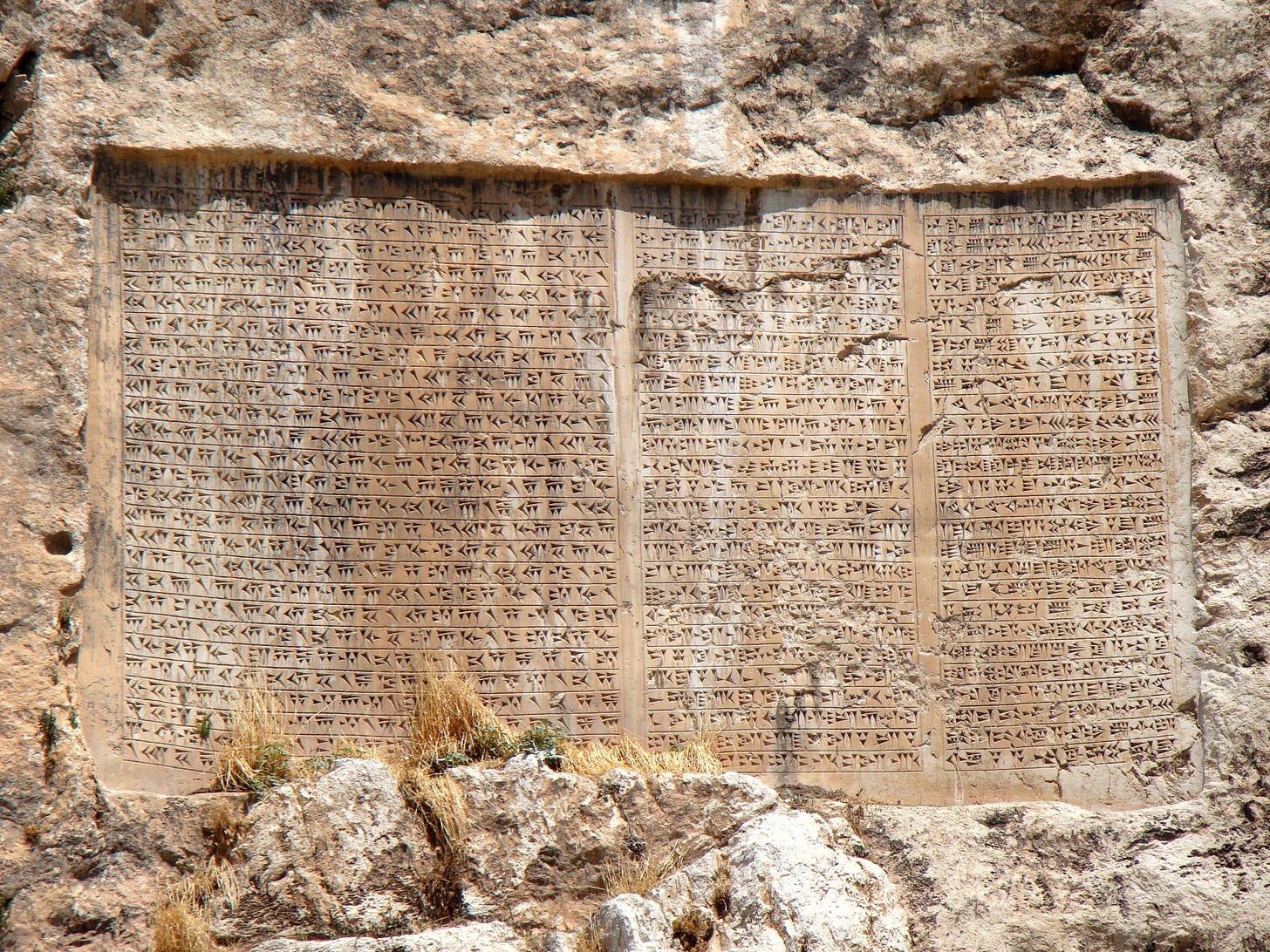The Time a Priest and his Bible Outsmarted the Cool Kids
Gather round, let me tell you a story.
Scholars have a way of delivering the wildest information in the blandest way possible. You almost have to remind yourself to be amazed by it. The Medieval biographer of William Marshal announces at the beginning of his book that “my subject concerns the worthiest man that ever was in our time, so help me God—and God grant me grace and the wit to treat it so that it will give pleasure and enjoyment to all who hear it in the proper spirit.” William’s Encyclopedia Britannica entry begins, “William Marshal, 1st earl of Pembroke (born c. 1146—died May 14, 1219, Caversham, Berkshire, England) was a marshal and then regent of England who served four English monarchs.” Gets the blood pumping.
One of my favorite crazy facts of all time is about how the Bible turned out to be way more trustworthy than the rationalist snobs of the 19th century. But it’s buried so obscurely in the archives of Ancient Near Eastern scholarship that you’d barely know it’s there.
First, a story: King Sennacherib of Assyria was the terror of the world. His Neo-Assyrian Empire was ravenous for blood and territory—Sennacherib’s predecessor, Ashurbanipal II, once erected a monument outside the walls of a city where he had subdued a rebellion. I say monument, but it was just a pillar covered with the flayed skins of the rebels.
At the turn of the 7th century B.C., during the reign of Sennacherib, King Hezekiah of Israel defaulted on his tribute payments to Assyria. Sennacherib descended on the Jewish homeland “like a wolf on the fold,” to quote Byron’s exhilarating poem about the incident. Despite Hezekiah’s promise to resume tribute, the bristling Assyrian army besieged the comparatively tiny city. It’s a famous confrontation because, at just that moment, King Hezekiah took the advice of the prophet Isaiah and prayed to God for deliverance.
“And it came to pass that very night,” says the Second Book of Kings, that God’s own angel smote thousands of Assyrian soldiers with deadly plague. When morning dawned, “behold: they were all of them dead bodies.”
Now, if you grew up as I did with history books that took the findings of archaeology for granted, you may have gotten the impression that stories like this have always been offset by the other point of view, recorded in archives and inscriptions from the Assyrian side of things. It comes as something of a shock when you first realize that those archives lay buried for thousands of years and only recently, two centuries or so ago, got dug back up by European explorers (thanks, empire!).
The annals of the ancient Mesopotamian world went off like a bombshell in learned society, blasting open the possibility of independent confirmation—or refutation—of the Biblical narrative. There was just the small problem that everything was written in cuneiform, a writing system that looks, in the words of historian Edward Dolnick, like “what you might get if a flock of birds with obsessive-compulsive disorder took a walk across wet clay.”
The Sumerian and Akkadian languages written in cuneiform were hard enough (and also lost), but recovering them was made vastly more difficult by the fact that the system used to write them had gone through multiple stages and transformations, ending up a little like the kind of patchwork that Japanese writing is today. Some characters are picture-symbols standing in for whole words, some are individual syllables, and many, unlike in Japanese, can be either depending on context. Figuring all this out was a bear.
The story of how it was done is told in Josh Hammer’s wonderful book The Mesopotamian Riddle. Hammer mercifully does not suffer from the scholar’s compulsion to make things dry, and he presents the effort to decode cuneiform as a dramatic three-way race between the dashing baronet Henry Rawlinson, soldier of the East India Company, the misfit archeologist Austen Layard, and the threadbare Irish parson Edward Hincks. Hincks was the least respected of the three, scraping by out in his country parish. He was also, it turned out, the most brilliant.
And there was one moment, it seems to me, that even Hammer doesn’t sensationalize enough. There was a set of inscriptions, from the palace of Dur-Sharrukin in today’s Iraq, which repeatedly spelled out the name of a certain king with two cuneiform signs. Names are indispensable for decipherment because they sound roughly the same in every language. Once you find them, you can use the letters and characters in them to decode other words—that’s how the Rosetta Stone was first cracked. Hincks realized that Akkadian was related to Hebrew, and he probably reckoned that the first character in the king’s name was Sarru based on the Hebrew word Sar, meaning “lord” or “ruler.” Based on what he already knew about cuneiform, he figured the second character could be “kinu,” meaning “is legitimate.” Sarru-kinu, the ruler is legitimate.
Sarru-kinu. Sarrkin…Sargon. The name of an Assyrian king mentioned at length in the Bible. If Hincks was right, this connected the inscriptions to a succession of kings that Rawlinson couldn’t get in his favored ancient Greek sources, from Sargon to his grandson Esharhaddon. And in between the two was Sargon’s son, none other than that old wolf Sennacherib. Using details found nowhere else in ancient literature other than the Bible, Hincks proceeded to fill in these three names, and the cuneiform signs they brought with them, all over the palace walls.
Meanwhile, Rawlinson scoffed. He was among the enlightened sophisticates who set more store by David Hume than by scripture. He insisted on reading the names of Sargon and Sennacherib as “Bel Adonim Shah” and “Arko-tsena,” sniffing down dead-end paths for years before finally changing course without ever, apparently, acknowledging that Hincks had been right.
It gets wilder. There was later discovered a clay prism on which Sennacherib himself had his attack on Jerusalem recorded. With typical kingly bluster he huffs and puffs about how he destroyed the cities around Jerusalem, how he “hemmed in Hezekiah like a caged bird” in the siege, and then…something something something. Sennacherib never says exactly what the outcome was of his assault on the Jewish capital, though there’s some boilerplate PR copy about the resumption of tribute payments mentioned in the Book of Kings. It sure sounds like a big gorilla trying to downplay the L he took.
So what really happened outside those walls? Why didn’t Sennacherib destroy Jerusalem like he was so fond of doing to all those other towns? Herodotus, in a much-altered version of the story, says a pack of magic mice swarmed over the Assyrian archers in the night and chewed through all their gear. Since mice are notorious plague-carriers, could this be a garbled telephone recording of the plague that struck after Hezekiah’s prayer?
I mean, I guess Assyria’s famously gore-happy killer could have marched all that way west, to the very borders of this trembling little city that had dared to defy him, and then decided to content himself with a higher tax rate. But it sure sounds like cope to me. And after seeing how Rawlinson, the toast of imperial England, got smoked by a little country pastor because the cool kids were ready to trust any source but the Bible? I’m sorry, but the smart money’s on the angel of the Lord.
At this point, today being good Friday, I feel compelled to offer a religious moral to this story—though not perhaps the one you’d expect. Don’t worry, if you find that sort of thing annoying I’ll put it below the paywall and you can just enjoy the crazy yarn above. But if you’re wondering what it’s all about, read on.
Keep reading with a 7-day free trial
Subscribe to Rejoice Evermore to keep reading this post and get 7 days of free access to the full post archives.






